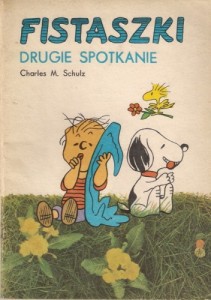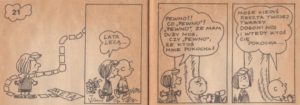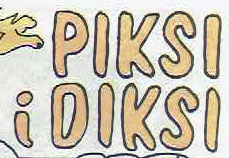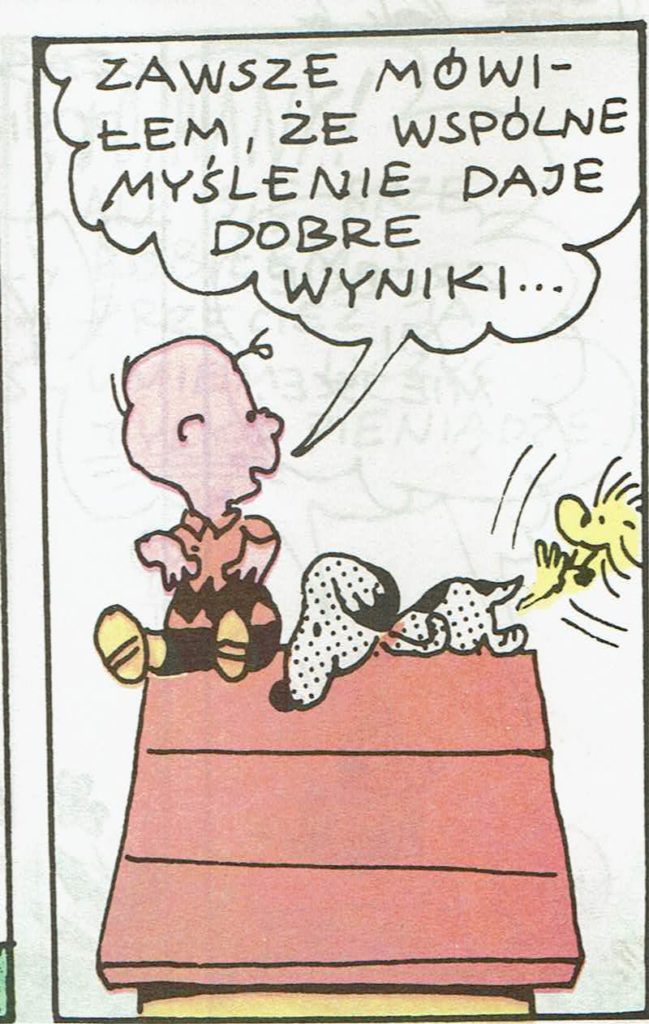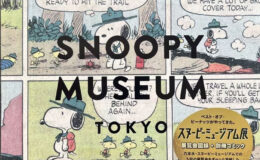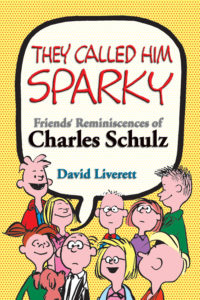I’m not sure if this proves the strength or weakness of communism
- By : Nat
- Category : Classic finds, Greatest hits, Reviews

Some of you will remember my fascination with (and love of) the set of badly traced bootleg Peanuts from communist-era Poland.
It was while chasing after more on this that I came upon something that might be even more amazing. Something I have instant love for, from the same publisher. I found their unauthorized 1988 comic book adaptation, The Return of Tarzan. And if you wonder whether I really should be posting this on a Peanuts blog… oh yes. But I’ll get to that. We’ll start at the beginning.
Now, I’m not enough of a Tarzan comics expert to be able to tell exactly what story or even which artist is being traced. If I had to place a guess, I’d say Burne Hogarth, but so many fine artists drew Tarzan comics over the year, their take was often influenced by Hogarth’s work, and the imprecise reinking eliminates the shaping and texture that would quickly indicate, say, Joe Kubert.
But if the comic were wall-to-wall Tarzan for all of its 48 self-covered pages, I would not find it worthy of mention. No, after 12-and-a-half pages of Jungle King action, the comic has, just as you guessed it, the comedic adventures of… Flip & Flap.
And if you think Flip & Flap look kind of like the classic film duo Laurel and Hardy, there’s a reason for that – it’s what Laurel and Hardy have always been called in Poland. In the 1960s, Larry Harmon (most famous as the man who brought Bozo the Clown to TV stations across the US) purchased the likeness rights for Laurel and Hardy, using them for coloring books, animation, and comic books. So this is an unlicensed version of that license. The comic has two Flip i Flap stories totaling 11 pages (with a few pages of prose pieces between them), so there’s almost as much of Laurel as there is of the Lord of the Apes.
It’s then that we get to the Peanuts material.
“Fistaszki i inne stworki…” translates to “Peanuts and other creatures…” and the other creatures come in on the bottom half of the page: it’s a drawing of Mickey Mouse displaying a photograph of a real baby mouse. So you turn the page, ready to find more Peanuts…
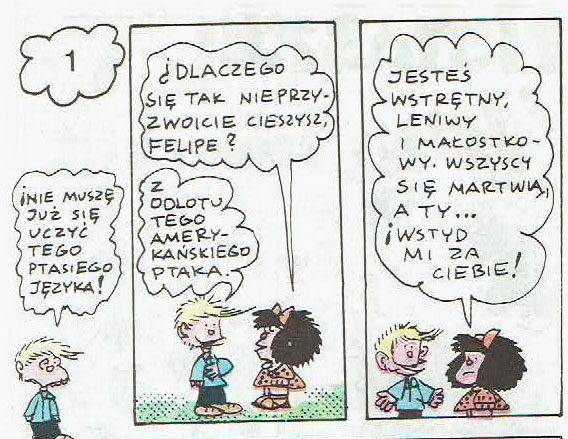 That’s not Peanuts! That girl’s Mafalda, the Argentine character beloved in much of the world, if unknown in the United States. And she and her friends are talking about writing a letter to Woodstock! Is that something that happened in Mafalda’s strip? I wouldn’t know; I’m here in the United States, and as a good and true American, I’ve utterly ignored Mafalda. But I do know that Mafalda’s creator Quino was influenced by Schulz, so it seems possible. I also know that Quino drew with more certainty than what you see here, as you can tell by this sample of the real work.
That’s not Peanuts! That girl’s Mafalda, the Argentine character beloved in much of the world, if unknown in the United States. And she and her friends are talking about writing a letter to Woodstock! Is that something that happened in Mafalda’s strip? I wouldn’t know; I’m here in the United States, and as a good and true American, I’ve utterly ignored Mafalda. But I do know that Mafalda’s creator Quino was influenced by Schulz, so it seems possible. I also know that Quino drew with more certainty than what you see here, as you can tell by this sample of the real work.
We get three pages of the Mafalda storyline, and then we get four whole pages of Peanuts.
Doesn’t that capture all the beauty of genuine Schulz?? No? And what about the choice to add shading to Snoopy? Genius, right?
But if you’re wondering which strips they’re awkwardly reprinting here, the answer is… none of them! In this story, the gang are helping Woodstock write a letter back to Mafalda, which I’m quite certain never took place in the strip. That’s right, this is all an original, unauthorized crossover! As long as they’re stealing other people’s toys, might as well have fun with them. (Although as far as crossovers go: they never actually meet face to face. They’re never on the same page, much less the same panel. They do live on different continents, after all, and continuity is sacrosanct.)
But with the Peanuts pages over, we can’t let the fun be over. No, we move right on to:
“Piksi i Diksi”? Oh, of course, Pixie and Dixie, the mice from the cartoons that used to be part of the old Huckleberry Hound show. They aren’t a big on the American cartoon nostalgia scene now, but it’s good to know that they remembered them in Warsaw in 1988.  Let’s take a look and see what kind of hijinks those two are getting up to (besides just saying “hi” to Mr. Jinks, of course):
Let’s take a look and see what kind of hijinks those two are getting up to (besides just saying “hi” to Mr. Jinks, of course):
That is neither pixie nor dixie. That three page story is quite blatantly Tom & Jerry (and Jerry’s cohort, who has been referred to variously as Tuffy and Nibbles.) What kind of bait-and-switch are they pulling here? That’s like offering someone a nickel, and giving them a quarter instead! It’s sacrilege I tell ya, sacrilege!
After that, we get three pages of fan letters for their earlier Peanuts books, and that wraps it up.
I’d always assumed that these were not technically bootlegs. I know that the Soviet Union didn’t always recognize foreign copyrights, and under rules like that, these would be just as legal as could be. Checking, I was remembering right, in part. The USSR didn’t recognize any foreign copyrights from before 1973. However, that’s no excuse for these publications. For one thing, the USSR started recognizing foreign copyrights from 1973 on, and some of the strips in their Peanuts collections were post-1973. For another thing, Poland, while on the same side of the Iron Curtain as the USSR and really acting as a satellite state, was still its own nation with its own laws. If I’m reading things right (and I am not a lawyer and it’s quite possible I’m missing something), it never got rid of the pre-communist laws with more general recognition of international copyright. So these books are a crime, in more ways than one.

